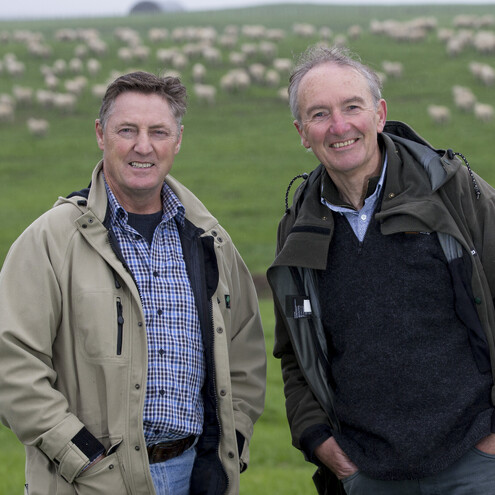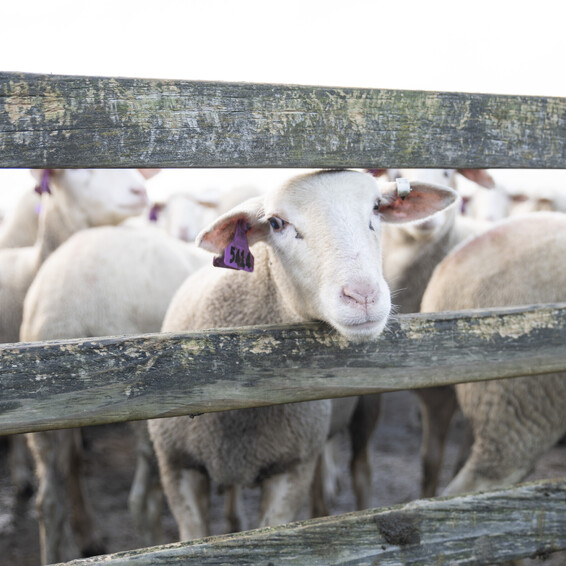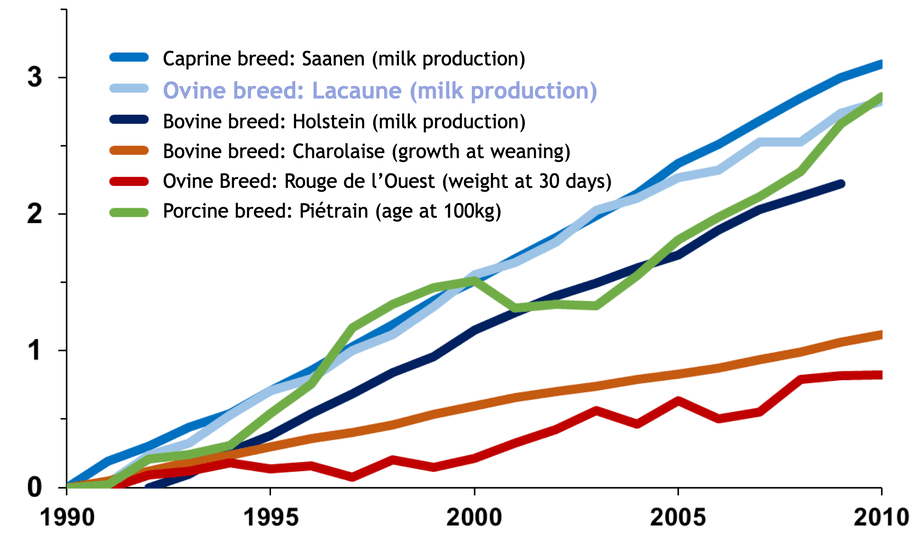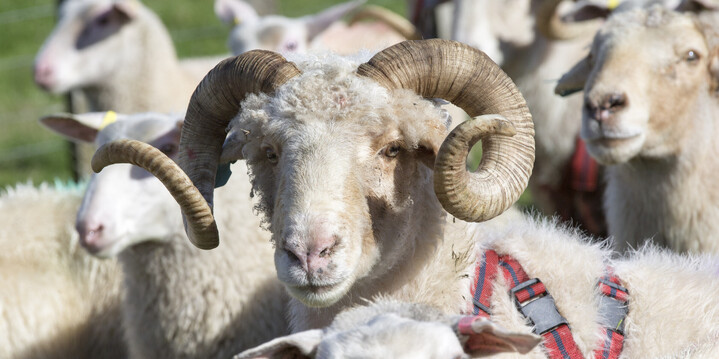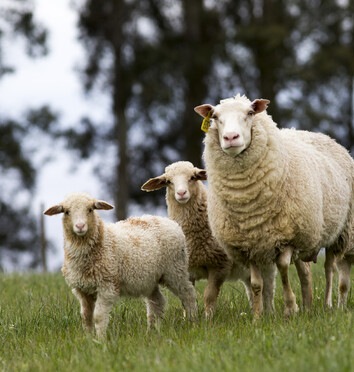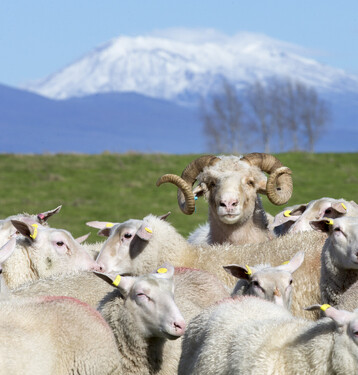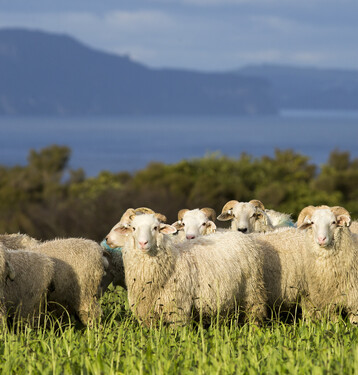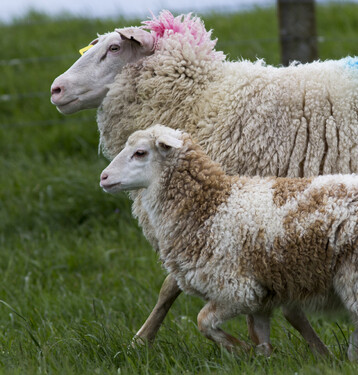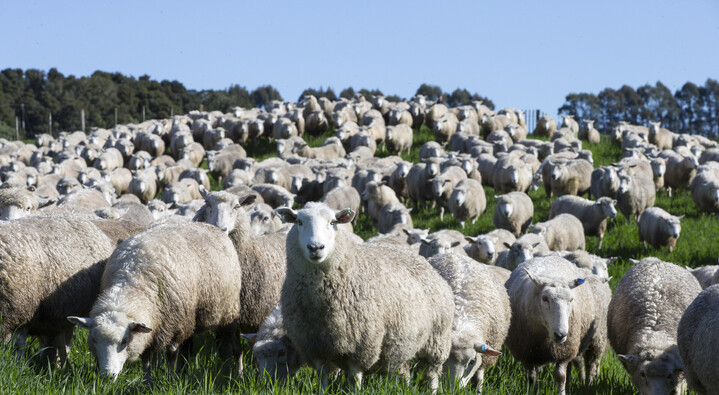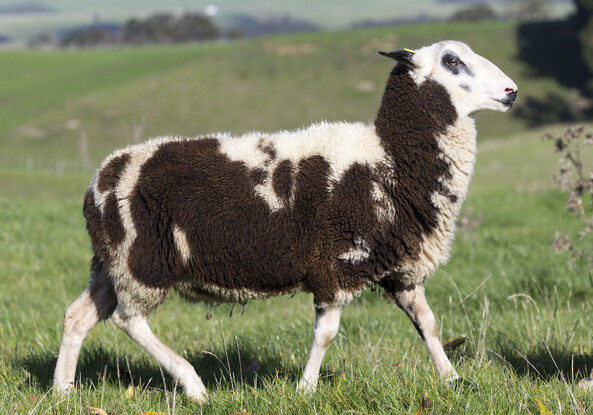Welcome to the home of the Southern Cross®
Maui Milk Ltd has developed a genetics program that combines New Zealand’s natural farming environment with a breeding strategy designed to produce sheep that thrive outdoors, achieve world-class milk yields, and enhance farm performance with each generation.
Sheep milk genetics programme established
In 2015 Maui Milk purchased Waikino Station farm, on the shores of Lake Taupo, and converted it to a dairy sheep operation—and home to Southern Cross® Dairy Sheep Technology.
When Maui Milk was formed in 2015, it was immediately evident that a new breed of sheep was needed, due to the existing operators routinely diluting the dairy genes available at that time to low levels to enhance ewe survival. The result was low yields.
In any livestock farming operation, it’s essential that the animals be well matched to the farm system, and the New Zealand system is unique.
Maui Milk choose to farm outdoors and created a seasonal, pastoral farm system, built a French internal rotary milking platform, cultivated an extensive area of lucerne for grazing and silage making, and established a unique genetics breeding programme to support their mission. Learn more about Maui Milk >>
Benefits of farming outdoors using a seasonal, pastoral system

Animal welfare
Our customers prefer milk to be produced by animals that have room to move, fresh air to breathe, and fresh pasture to eat.

Sustainable farming
Sheep have a lighter environmental ‘hoofprint’ than cows.

Milk supply
The New Zealand climate suits outdoor farming, and it is more efficient, provided of course that the farmers have suitable dairy ewes.
The Southern Cross® breed—for Maui Sheep Milk
Maui Milk employed specialists to develop a sheep dairy breed suitable for the New Zealand outdoor farming environment.
Peter Gatley and Jake Chardon had extensive experience running genetic programmes, Peter as General Manager Genetics for LIC (responsible for breeding most of New Zealand’s dairy cows), Jake as CEO of Holland Genetics (a truly global bovine dairy genetics company). They were soon joined by Marion Benoit bringing valuable experience from France which is regarded by many as the home of the most highly developed sheep dairy industry.
After performance testing several potential foundation breeds they identified those with the most to contribute to the creation of a composite breed incorporating northern hemisphere genes in a form suited to our farm environment – the Southern Cross®.
The Southern Cross has been accepted by the New Zealand Sheep Breeders Association as a new breed, and the name is protected by Trade Mark.
Our breeding goal
Efficient conversion of pasture into profit.
The first task of any genetic improvement programme is to identify the most appropriate breeding goal.
For the Maui Milk genetics team, this was easily done. Peter and Jake had observed the evolution of the bovine industry’s goal and the lessons learned from unbalanced focus, whether that be on gross production or Traits Other than Production.
Image from left: Peter Gatley and Jake Chardon
Pasture into profit
Refinement over decades resulted in the development and adoption of an industry-good goal for dairy cattle summarised as the efficient conversion of pasture into profit.
The principles of converting grass into milk apply equally in sheep dairy.
Accordingly, the key traits of interest closely match those in the bovine industry:
- Milk yield
- Components
- SCC
- Liveweight
- Udder conformation
The Southern Cross®
Geneticists recognise a phenomenon known as GxE (“G by E”, or Geneotype by Environment interaction).
This refers to the fact that animals ranked in one farm system re-rank when tested in another. It is essential that a genetic programme be matched to the farm system in which progeny will need to perform, so genetics developed for one system need to be adapted for another.
The NZ dairy cattle industry has shown the value of genetic diversity and hybrid vigour in creation of a milking animal
for a different farm system. In New Zealand there are
Holstein Friesian cows and Jersey cows, but these differ significantly from the bloodlines farmed intensively in the northern hemisphere.
The NZ animals have been performance tested and selected for more than a century in a seasonal pastoral farm system quite different to the barns of Wisconsin and Europe.
New Zealand farmers milking cows have also learned first-hand the value of crossbreeding.
Decades ago, when they were paid only for cream, they favoured the brown (Jersey) cows with the high milkfat. When payment for protein was introduced, they shifted to the Black & White option. Along the way they realised that they had created some outstanding animals that were mid-sized and mostly black, they got in calf and walked and grazed and lasted longer than the pure breeds. This cow became known as the Kiwicross and is now New Zealand’s favourite.
Our trials proved that the Lacaune had the dairy traits we needed, and Coopworth complemented these.
Maui Milk geneticists evaluated candidate sheep breeds with the intention of creating a ‘Kiwicross’ dairy ewe.
This would necessitate the combination of dairy genes with those best suited to the pasture-based system. Our trials proved that the Lacaune had the dairy traits we needed.
Breeders creating composites for the sheep meat industry in the 1990s saw the high lambing percentage of the East Friesian as a positive, but when East Friesian genes predominate, they produce too many triplets.
The Awassi bloodlines in Israel can certainly milk, but those in New Zealand are meat sheep. Their temperament was found to be less than ideal, and their lambing percentage sits well below the optimum with too many singles.
Having settled on the Lacaune as the source of dairy genes, it was immediately obvious where we would find the complementary breed to ensure performance in the all-outdoor system.
Just as NZ dairy cattle farmers discovered the Kiwicross while moving from Jersey to Friesian, we discovered the Southern Cross while moving from Coopworth to Lacaune. In both cases the hybrid vigour is a bonus, but a very useful one.
Characteristics of the Southern Cross®
The Southern Cross has been accepted by the NZ Sheep Breeders Association as a new breed, and the name has been Trade Marked.
> Liveweight
Mature ewes weigh about 75kg. The target mating weight for hoggets is 50kg and they are expected to continue growing through their first pregnancy to start milking at 60kg after lambing. Maintenance feed costs vary with size so larger animals need a corresponding higher level of production to offset this. As observed in the dairy cattle industry, this will not result in small animals, but it will make it less likely that we will breed ever larger ones.
We've found ewes of around 75kg liveweight to be efficient producers and easier to handle than much larger animals. By comparison many East Friesian ewes weigh around 85-95 kg.
> Milk quality
Virtually everything in sheep milk is more concentrated than cow milk, and the threshold for SCC is 700k compared to 400k in cow milk.
> Milk yield
Prior to 2017, large commercial herds produced between 100 and 150 litres per ewe per lactation. In France the genetic programme has been increasing yield annually at about 5 litres per ewe per lactation and sits at about 400 litres. Southern Cross® ewes with 75% Lacaune genes are now producing about 350 litres in 200-240 days.
> Components
Virtually all of our milk is processed into powder so the same applies for Maui Milk suppliers who are paid for solids. The percentage Total Solids (including lactose) varies through the season in New Zealand and averages just under 18% (compared to less than 12% for cows and goats).
In future it is expected that Maui Milk will apply differential payout values to milkfat and protein. Whereas in cow dairy the relative value of milkfat has overtaken protein, protein currently delivers the greater value per unit in sheep dairy.
> Udder conformation
Lacaune is the clear leader on udder morphology and this is reflected in Southern Cross® ewes.
> Wool
All potential source breeds produce coarse wool offering little benefit from selection pressure. Shearing is regarded as an animal health and welfare issue, with implications for productivity. The Southern Cross® exhibits the Lacaune trait of a clean neck and belly, evident on our second and third generation sheep. The staple is not long but shearing typically takes place twice annually – pre-lamb and during lactation. We are still shearing twice a year but if in the future the wool market isn't as attractive as present, we may be able to shear once a year.
> Feet
Grazing animals need to walk freely and lameness is to be avoided. This is a notoriously difficult goal for sheep generally, especially on productive (rather than very dry) land. Source genes are subject to selection pressure and Southern Cross® animals selected as sire rams or ram mothers must have sound feet. Feet require monitoring and foot bathing and trimming is common practice or will allow the ewes to perform to their genetic potential.
> Fertility
We have found Southern Cross® ewes to be highly fertile. There is no problem creating pregnancies so it is important to be disciplined in the approach to hogget mating. Small hoggets will get pregnant but must be well grown to show their genetic potential for milk production.
> Lambing percentage
Ewes typically scan at 160-180% which is ideal. Twinning
is maximised.
> Facial eczema
There is no performance testing of rams for FE tolerance as the trade-off against other traits would be unacceptable. Management options include pasture spraying, zinc supplementation and particularly, use of crops such as chicory and lucerne. Alternative grassing options have an important role to play during the FE season as ryegrass is generally sub-optimal at that time of year anyway,
and good nutrition is important in late lactation and the tupping season.
> Carcass conformation
As dairy animals, Southern Cross® are slower to finish than animals bred primarily for the meat industry, but they are ultimately weighed, graded and subject to the same meat schedules as other sheep. French farmers with Lacaune animals earn about 30% of their income from meat and
the breed retains some selection pressure on
carcass conformation.
Southern Cross® Rams
Southern Cross® rams are bred on Waikino Station where ewes are performance tested and recorded in a commercial environment, and the best are selected as ‘ram mothers’. They are mated with progeny tested sires via laparoscopic (surgical) Artificial Insemination and all progeny are DNA parentage tested to ensure recording accuracy.
Teams of Southern Cross® rams are leased to Maui Milk suppliers for each mating season. This system offers the farmer several benefits:
Two tooth rams are supplied at a ratio of about 1 ram:70 ewes ensuring plenty of sires to do the job.
A new cohort of rams is supplied every year to ensure genetic gain and genetic diversity while avoiding inbreeding.
Genetic diversity is further enhanced by the use of complementary bloodlines within each team of rams.
All rams have several progeny tested sires in their pedigrees.
Farmers do not need to have rams on the property outside the tupping season.
Get in touch with our genetics team
Lacaune
French agriculture is famous for its
operation of large scale, scientific genetic programmes—their sheep dairy industry ranking among the best.
The Lacaune breed is the mainstay of the French industry which is most famous for its Roquefort cheese. Only milk from the Lacaune breed can be used to make Roquefort. About 2000 herds totalling 800,000 ewes are milked in the south of France where the cheese is aged in limestone caves, as it has been for hundreds of years.
Created in the 19th century in France from small local breeds, the Lacaune has been selected for more than 60 years. Lacaune breeders decided to join their efforts in a cooperative system and focus on improving their ewes to fit their industry, market and needs. They developed a national performance record and genetic evaluation system that enabled the Lacaune to be become the first dairy breed in the country, and the first dairy sheep breed to access genomic selection in the world.
The Lacaune breed is selected to improve milk yield, but more traits were added to the program strategy overtime (like high components and low somatic cell count) that are important for (raw) cheese making and good udder conformation. Also, there are two Lacaune breeds in France. One is specialised in milk production and the other is dedicated to meat production—showing that the breed can produce good lambs too.
The graph shows genetic improvement in milk production equating to nearly
3 standard deviations during the period from 1990 to 2010.
There are several features of the French genetic programme that make the Lacaune the most attractive source of dairy genes for a New Zealand hybrid.
> Farm system
The continental climate in France can be severe and ewes are housed for most of the year, but are routinely grazed daily during summer unless it is very wet. This is different to the way we operate in this country but grazing plays a much larger role in France than it does in the northern European countries where the East Friesian has developed. French farmers supplying milk for Roquefort are required to lamb their Lacaune in mid-winter because this suits the cheese manufacturing process, so housing is especially important at that time of year, though fully indoor farming is forbidden.
Even if they must be housed through winter, the French Lacaune breeders are very attached to ancestral pastoralism practices and maximise grazing time as much as possible. The breed has also proved itself in hotter and drier countries like Spain and is also found in the French Alps and Pyrenees where they seem to cope well with a colder climate.
> Trait selection
The ISOL net production index is focussed on selection criteria that closely match our requirements:
- Milk yield – The cost of farming and milking a ewe is largely fixed so yield has a large impact on profitability.
- Components – The French make cheese and we make powder, so value is in components rather than litres.
- Somatic Cell Count – This is a strong indicator of milk quality and udder health, and has a direct impact on the shelf life of finished goods.
- Liveweight – The relationship between liveweight and production is a key indicator of efficiency.
- Udder conformation – Milking throughput has major implications for labour efficiency and farm financial performance so well-attached udders with good teat placement are highly valued. For example, low udder, udder with no or a small cleft or with teats closer to the horizontal angle are linked to higher SCC.
> Genetic improvement programme
While sheep identification is compulsory in France, herd testing and recording is standard practice across many herds in France and the protocol used is standardised (and ICAR certified). The results are centralised at the national scale and used to create across-herd evaluations.
The best rams are selected on ancestry information, phenotype (they all need to match the Lacaune morphological standard and have strong feet and back), screened using genomics, and progeny tested. There is no substantial across-flock evaluation system for any dairy sheep breed anywhere in the world.
Fresh semen enables the use of cervical AI and replacements are routinely bred using progeny tested sires. In comparison, there is no substantial across-herd evaluation system for the East Friesian breed anywhere in the world.
> Selection intensity
The success of the Lacaune genetic programme has resulted in the breed becoming by far the most popular in France. 800,000 ewes are milked, and several hundred thousand are actively involved in multi-herd evaluation and selection. By comparison, the total number of East Friesian ewes milked in Europe is measured only in tens of thousands.
> Genetic diversity
The size of the Lacaune gene pool is impressive, and diversity is enhanced by the fact that there are two strong breeding programmes operating quite independently (Ovitest and Confederation).
The two programs are operating separately using different pedigree but they both follow the same genetic strategy/direction and fit into the same performance and genetic evaluation system.
Awassi
The Awassi breed is most famous for the fat-tailed sheep favoured for consumption in Middle-Eastern countries, but some are recognised as excellent milk producers, particularly in Israel.
With no chance of importation from that part of the world, Peter and Jake located the only significant Awassi population in New Zealand and struck a deal with the Saudi Arabian owners who had established the operation with the intention of live-export (which was no longer allowed).
Five rams were leased in 2016 and mated over pure East Friesian ewes at Waikino.
The resulting cross has similarities with the combination of the same two breeds to become a popular milking option in Spain known as the Assaf.
The distinctive offspring, with unusual ‘hairy’ wool, some horns, fat tails and a variety of colours, were added to the milking mob in 2017.
Coopworth
The limited number of pure East Friesian rams resulting from the 2015 embryo programme were used to begin upgrading large numbers of ewes by creating F1 offspring. The maternal breed was chosen on the advice of Dr Allison who had observed many East Friesian crosses during the 1990s and was most impressed with the Coopworth.
The Coopworth was developed by researcher Ian Coop at Lincoln College in the late 1950s as a dual purpose (meat & wool) producer. It resulted from Romney ewes being mated to Border Leicester rams, and is recognised as easy-care, highly productive in a pasture system, with excellent temperament and great mothering instinct.
The breed made rapid genetic progress based on strict selection criteria using data rather than phenotype, so progress was not slowed in pursuit of ribbons in the show ring.
4000 Coopworth ewes were selected from several top-ranked NZ North Island studs.
When we established our breeding nucleus at Waikino Station, 4000 Coopworth ewes were selected from several top-ranked North Island studs and were mated in 2016, wintering well on the shores of Lake Taupo to produce first-cross offspring in spring.
East Friesian Rams + Coopworth Ewes
The pure East Friesian rams from
the embryo programme were mated to Coopworth ewes in 2016 and the resulting F1s were also milked at Waikino.
Recognising that the 1992 importation represented an extremely small gene pool and therefore did not provide the best foundation for a sheep milking industry, our team looked for outcross options. No ovine germplasm had been allowed into NZ from the UK or Europe for about 25 years because of biosecurity concerns, but Dr Allison and veterinarian Ken Cottier were enlisted to work alongside MPI to create an import protocol.
This work enabled new East Friesian bloodlines to be imported from the UK in time for the 2017 mating season when embryos were implanted into surrogate mothers
at Waikino.
Coopworth ewes pictured.
East Friesian
Prior to 2018, virtually all dairy ewes milked in New Zealand traced their ancestry to a very small group of East Friesian (EF) animals imported in 1992 by Dr Jock Allison who was head of the Invermay Research Centre near Dunedin. Four rams and eleven pregnant ewes were brought to this country to improve specific traits in maternal lines of composite sheep bred for the meat and wool industries.
They contributed greatly in pursuit of this objective by lifting lambing percentage from low levels and increasing milk production to feed the lambs. They were, however, unsuited to provide the foundation for a sheep dairy industry.
The East Friesian used to lead on milk production, but the Lacaune has caught up over the past several decades, especially when size of the animal is taken into account.
On the other hand, EF ewes are more prone to sunburn (especially on the pink nose and ears), and we have also observed more pneumonia.
In 2015, importation of new genetic material was not allowed by MPI so our genetics team set about making the most of what was available. At the national SheepmilkNZ conference Jake and Peter were in discussion with Dr Allison and discovered that many frozen embryos remained in storage after being collected in the 1990s.
Within a few weeks all 1700 were implanted into Highlander ewes at Awapai in Hawkes Bay.
Some straws of EF semen were also inseminated into Highlander ewes so this programme provided pure EF as well as first-cross (F1) progeny which were later milked on Waikino Station.



